|
|
|
Sort Order |
|
|
|
Items / Page
|
|
|
|
|
|
|
| Srl | Item |
| 1 |
ID:
158166
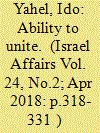

|
|
|
|
|
| Summary/Abstract |
This article compares and contrasts the relations among the three Jewish underground groups in Mandatory Palestine ‒ the Hagana, the Irgun and LEHI ‒ with three anti-colonial national liberation movements: in Malaya, Algeria and Vietnam. It shows that the fact that the Jewish resistance movement had the fewest divisive elements enabled it to unite its three distinct components, however briefly (in 1945–1946), though the reappearance of the divisive factors led to the dismantlement of the united front and to each organisation conducting its own struggle for national liberation.
|
|
|
|
|
|
|
|
|
|
|
|
|
|
|
|
| 2 |
ID:
146116
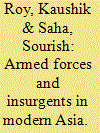

|
|
|
|
|
| Edition |
South Asia ed.
|
| Publication |
Oxon, Routledge, 2016.
|
| Description |
xii, 246p.: mapshbk
|
| Standard Number |
9781138210431
|
|
|
|
|
|
|
|
|
|
|
|
Copies: C:1/I:0,R:0,Q:0
Circulation
| Accession# | Call# | Current Location | Status | Policy | Location |
| 058724 | 355.0218/ROY 058724 | Main | On Shelf | General | |
|
|
|
|
| 3 |
ID:
181275
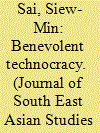

|
|
|
|
|
| Summary/Abstract |
The Chinese Protectorate was first established in Singapore in 1877 with the limited objective of preventing abuses in Chinese labour migration, but it evolved multiple functions dedicated to governing Chinese migrants and residents in colonised Malaya. The Protector possessed extensive statutory powers and he was regarded as the official authority on all matters ‘Chinese’. This was an important yet under-studied colonial institution in the history of Chinese migration and settlement in Singapore and Malaysia. This article narrates the history behind the establishment of the Protectorate in the 1870s when ‘racialised governmentality’ of the Chinese population was institutionalised in colonised Malaya. The article underscores the significance of imperial and local contexts of the Protectorate's creation, arguing that it was a product of flexible adaptation of empire-wide practices of ‘protecting’ and governing liberated slaves, indigenous peoples and subsequently, indentured Indian labourers ‘humanely’. It is notable, therefore, that there was a coeval and conjoined discussion of migration control of Chinese as well as Indian labour migrants in Malaya during this period, but this history is hidden from plain sight by popular approaches studying labour migration as components of ethnic diasporas migrating from a single point of origin.
|
|
|
|
|
|
|
|
|
|
|
|
|
|
|
|
| 4 |
ID:
183466
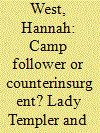

|
|
|
|
|
| Summary/Abstract |
British counterinsurgency thinking today remains strongly influenced by the Malaya Emergency (1948–1960) but little-known is the extensive women’s outreach program, pioneered by Lady Templer, involving the Women’s Institute and British Red Cross. Through discourse analysis of archival records, this article identifies four discourses characterizing British women’s participation, used, at the time, to make acceptable their presence whilst distancing them from the counterinsurgency campaign. By exploring how women’s presence has been negotiated and marginalized, I will reveal the blurred boundaries of counterinsurgency, questioning how the role of the counterinsurgent is constructed and sustained over time and for what purpose.
|
|
|
|
|
|
|
|
|
|
|
|
|
|
|
|
| 5 |
ID:
143246
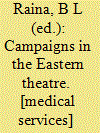

|
|
|
|
|
| Publication |
DelhI, Manager of Publications, Govt. of India, 1964.
|
| Description |
xxii, 525p.: ill., mapshbk
|
| Series |
Official history of the Indian Armed Forces in the Second World War 1939-45
|
|
|
|
|
|
|
|
|
|
|
|
Copies: C:1/I:0,R:0,Q:0
Circulation
| Accession# | Call# | Current Location | Status | Policy | Location |
| 007321 | 300/RAI 007321 | Main | On Shelf | General | |
|
|
|
|
| 6 |
ID:
146209
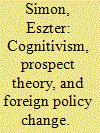

|
|
|
|
|
| Summary/Abstract |
This article investigates the cognitive limitations on policy change in counterinsurgency (COIN) efforts by examining why American decision-makers failed to revise their government strategy substantially while fighting the insurgency in Afghanistan in 2003–2014 and why their British counterparts were more successful in adjusting their policies in the Malayan insurgency in 1948–1954. Unlike most of the COIN literature that concentrates on military strategy and tactics, the analysis of government policy-making in Malaya holds some important political lessons for American leaders today despite differences between the insurgencies in Afghanistan and British Malaya. As a response to the criticism of COIN studies in general that they lack theoretical guidance, this article utilizes an integrated cognitivist-prospect theory framework. It is argued that some of the COIN literature mistakenly suggests that a more difficult strategic situation was primarily responsible for American failure in Afghanistan. Instead, American decision-makers faced a more difficult task cognitively than their British counterparts, as policy change in Afghanistan would have required greater ideational change. American principals were much more attached to their beliefs emotionally, had no alternative problem representation, and had to shift between frames in order to engineer a response that was more in line with events on the ground in Afghanistan. Regarding prospect theory, findings indicate that gains frames appear to be unhelpful in monitoring progress until catastrophic failure endangers the reference point, and that decision-makers often have more than one reference point to attune their policies to, which often results in suboptimal choices with regard to at least one reference point.
|
|
|
|
|
|
|
|
|
|
|
|
|
|
|
|
| 7 |
ID:
139110
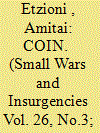

|
|
|
|
|
| Summary/Abstract |
Has the US military become a learning institution, one able to transition from relying on a conventional war model to fighting against irregular adversaries such as insurgents and terrorists? This article examines the United States' interventions in Iraq and Afghanistan in an effort to respond to this question. It shows that there are two major ways for a military to fail to be a ‘learning’ institution: It may stick to its old dogma or – adopt a flawed new one. Those who saw counterinsurgency (COIN) doctrine as the best way to stabilize Iraq and Afghanistan made the US military into a learning organization – but taught it the wrong lesson. They failed to take into account the absence of the sociological conditions that make a post-conflict environment amenable to nation-building, which is an integral part of the main variants of counterinsurgency. The article closes by outlining the foremost reasons the US military continues to be a poorly adaptive organization.
|
|
|
|
|
|
|
|
|
|
|
|
|
|
|
|
| 8 |
ID:
139111
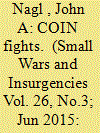

|
|
|
|
|
| Summary/Abstract |
Etzioni both exaggerates and minimizes the influence of my book Learning to Eat Soup with a Knife on different components of US military doctrine, mischaracterizes my treatment of the Malayan Emergency, and unfairly denigrates the successes of counterinsurgency in Iraq from 2007 to 2011 while misattributing the reasons for its failures in both Iraq and Afghanistan.
|
|
|
|
|
|
|
|
|
|
|
|
|
|
|
|
| 9 |
ID:
090705
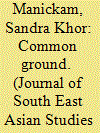

|
|
|
|
|
| Publication |
2009.
|
| Summary/Abstract |
This article explores the common bases of knowledge on race among Malay intellectuals and British scholar-officials in British Malaya. It focuses on genealogies of knowledge that not only lead back to Europe, but to contexts in the Malay Archipelago, encompassing both coloniser and colonised as agents of production of colonial knowledge on race. Race was a strategy adopted by Malay intellectuals in a colonial milieu, in line with histories and conditions before and during the period of British control over Malaya. The notion of complicities is explored in studying the interaction between British and Malay intellectuals which produced colonial knowledge on race.
|
|
|
|
|
|
|
|
|
|
|
|
|
|
|
|
| 10 |
ID:
128578
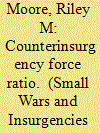

|
|
|
|
|
| Publication |
2013.
|
| Summary/Abstract |
As a consequence of intervention in Iraq and Afghanistan, force ratio for counterinsurgency (COIN) has come under increased scrutiny. Reduced to its essence, the issue is simply, 'How many troops does it take to get the job done?' This answer has been sought by the US military, academia, and think tanks. There have been numerous responses, culminating in several 'plug-and-play' equations for minimum force ratios in COIN operations. Due to the impossibility of determining precisely how many insurgent forces there are, it has become common to base force ratios on the population of the country. In the realm of policy, the question above is posed as, 'How many of our troops does it take to get the job done?
|
|
|
|
|
|
|
|
|
|
|
|
|
|
|
|
| 11 |
ID:
093094
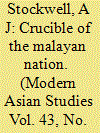

|
|
|
|
|
| Publication |
2009.
|
| Summary/Abstract |
Like so many features of the British Empire, policy for colonial higher education was transformed during the Second World War. In 1945 the Asquith Commission established principles for its development, and in 1948 the Carr-Saunders report recommended the immediate establishment of a university in Malaya to prepare for self-government. This institution grew at a rate that surpassed expectations, but the aspirations of its founders were challenged by lack of resources, the mixed reactions of the Malayan people and the politics of decolonisation. The role of the University of Malaya in engineering a united Malayan nation was hampered by lingering colonial attitudes and ultimately frustrated by differences between Singapore and the Federation. These differences culminated in the university's partition in January 1962. In the end it was the politics of nation-building which moulded the university rather than the other way round.
|
|
|
|
|
|
|
|
|
|
|
|
|
|
|
|
| 12 |
ID:
115292
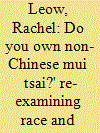

|
|
|
|
|
| Publication |
2012.
|
| Summary/Abstract |
This paper considers the abolition of the mui tsai (young female bondservants) as it unfolded in British Malaya, and challenges the overemphasis on Hong Kong as the primary focus of mui tsai scholarship. While the mui tsai system was defended as a time-honoured Chinese tradition, this paper uses new material to show that trans-racial considerations figured prominently in mui tsai abolition in Malaya, particularly in helping to recast it as a wider problem of child welfare. It is argued that this neglected aspect of mui tsai abolition only comes clearly to light in the Malayan case; for only in the intensely multi-racial conditions of peninsular Malaya could the question be asked: 'Do you own non-Chinese mui tsai?'
|
|
|
|
|
|
|
|
|
|
|
|
|
|
|
|
| 13 |
ID:
165386
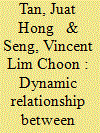

|
|
|
|
|
| Summary/Abstract |
Using a panel cointegration approach, this study examines the relationship between aggregate consumption and GDP in colonial Malaya (1900–39) and post-independence Malaysia (1970–2009). The findings suggest that private consumption and GDP are cointegrated across the two forty-year periods, indicating a stable relationship in the long run. This is significant as the two periods are completely bipolar in terms of economic structure, stage of development and economic management. The vector error-correction models reveal that adjustment to long-run equilibrium is achieved through changes in both consumption and GDP, though the response of GDP to disequilibrium is stronger. Cointegration regressions of DOLS and FMOLS are used to estimate the marginal propensity to consume (MPC) between the two periods.
|
|
|
|
|
|
|
|
|
|
|
|
|
|
|
|
| 14 |
ID:
171959
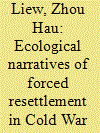

|
|
|
|
|
| Summary/Abstract |
This article examines the forced resettlement of more than 500,000 ethnic rural Chinese during the Malayan Emergency that lasted from 1948 until 1960. The phrase “winning the hearts and minds of the people” encapsulates the British narrative of economic uplift and development, evident from the naming of sites that rural Chinese were moved to as “New Villages.” This justification of Cold War counterinsurgency strategy through development is apparent in the British pamphlet, “The Story of Permatang Tinggi New Village,” which casts rural Chinese as a primitive people without history, transformed into productive and loyal citizens after resettlement. Yet, oral histories and cultural productions by resettled villagers challenge this, as seen in the essays and poetry of villager Wong Yoon Wah. Whereas the British presented rural Chinese as rootless squatters, Wong portrayed another world in which the longstanding Nanyang connection to the ecology of the tropics manifest in fish who live in ponds beside tin mines, and bats whose night time flights of pollination are upset by the chaos of the Emergency. His writings counteract “hearts and minds” by reclaiming the rural jungle in which they worked and lived as homelands lost to British resettlement.
|
|
|
|
|
|
|
|
|
|
|
|
|
|
|
|
| 15 |
ID:
117187
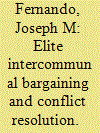

|
|
|
|
|
| Publication |
2012.
|
| Summary/Abstract |
Between 1949 and 1951, the Communities Liaison Committee (CLC), an unofficial body comprising leaders from the main Malayan ethnic communities, served as a prototype for elite intercommunal conflict resolution during a very challenging period amid an ongoing communist insurgency. Drawing upon previously inaccessible primary sources, this article reassesses the CLC's work towards resolving divisive issues such as Malay economic backwardness, federal citizenship, national identity, education and language in Malaya. This article argues that the CLC played a significantly bigger role than previously recognised and influenced government policy considerably. Equally importantly, it entrenched the concept of consociationalism, which was to shape the Malayan political landscape long thereafter.
|
|
|
|
|
|
|
|
|
|
|
|
|
|
|
|
| 16 |
ID:
030092
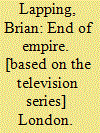

|
|
|
|
|
| Publication |
London, granada Publishing, 1985.
|
| Description |
xvi, 560pHbk
|
| Standard Number |
0246119691
|
|
|
|
|
|
|
|
|
|
|
|
Copies: C:1/I:0,R:0,Q:0
Circulation
| Accession# | Call# | Current Location | Status | Policy | Location |
| 025489 | 909.09171241/LAP 025489 | Main | On Shelf | General | |
|
|
|
|
| 17 |
ID:
084661
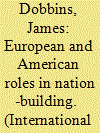

|
|
|
| 18 |
ID:
116255
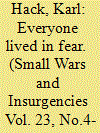

|
|
|
|
|
| Publication |
2012.
|
| Summary/Abstract |
Recent research on Palestine, Kenya, and Malaya has emphasised the coercive nature of 'Britain's dirty wars'. Abuses have been detailed and a self-congratulatory Cold War-era account of British counter-insurgency - as 'winning hearts and minds' and using minimum force - subjected to intensifying attack. The result has been a swing from over-sanitised narratives of the primacy of 'winning hearts and minds', towards revisionist accounts of relentless coercion, the narrowly coercive role of the army, and of widespread abuses. This article argues that, if Malaya is anything to go by, the essence of Cold War-era British counter-insurgency victories lay neither in 'winning hearts and minds' per se, nor in disaggregated and highly coercive tactics per se. Rather, it lay in population and spatial control in the which the interaction of both was embedded. In Malaya British tactics during the most critical campaign phases counterpoised punitive and reward aspects of counter-insurgency, in order to persuade people's minds to cooperate, regardless of what hearts felt. This article thus makes the case for avoiding artificial contrasts between 'winning hearts and minds' and a 'coercive' approach, and instead for a new orthodoxy focusing on their roles within the organising framework at play during successful phases of counter-insurgency.
|
|
|
|
|
|
|
|
|
|
|
|
|
|
|
|
| 19 |
ID:
034857
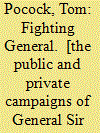

|
|
|
|
|
| Publication |
London, William Collins Sons and Co. Ltd, 1973.
|
| Description |
280p.Hbk
|
| Standard Number |
0002112957
|
|
|
|
|
|
|
|
|
|
|
|
Copies: C:1/I:0,R:0,Q:0
Circulation
| Accession# | Call# | Current Location | Status | Policy | Location |
| 011969 | 923.541/POP 011969 | Main | On Shelf | General | |
|
|
|
|
| 20 |
ID:
153632
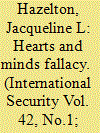

|
|
|
|
|
| Summary/Abstract |
Debates over how governments can defeat insurgencies ebb and flow with international events, becoming particularly contentious when the United States encounters problems in its efforts to support a counterinsurgent government. Often the United States confronts these problems as a zero-sum game in which the government and the insurgents compete for popular support and cooperation. The U.S. prescription for success has had two main elements: to support liberalizing, democratizing reforms to reduce popular grievances; and to pursue a military strategy that carefully targets insurgents while avoiding harming civilians. An analysis of contemporaneous documents and interviews with participants in three cases held up as models of the governance approach—Malaya, Dhofar, and El Salvador—shows that counterinsurgency success is the result of a violent process of state building in which elites contest for power, popular interests matter little, and the government benefits from uses of force against civilians.
|
|
|
|
|
|
|
|
|
|
|
|
|
|
|
|
|
|
|
|
|